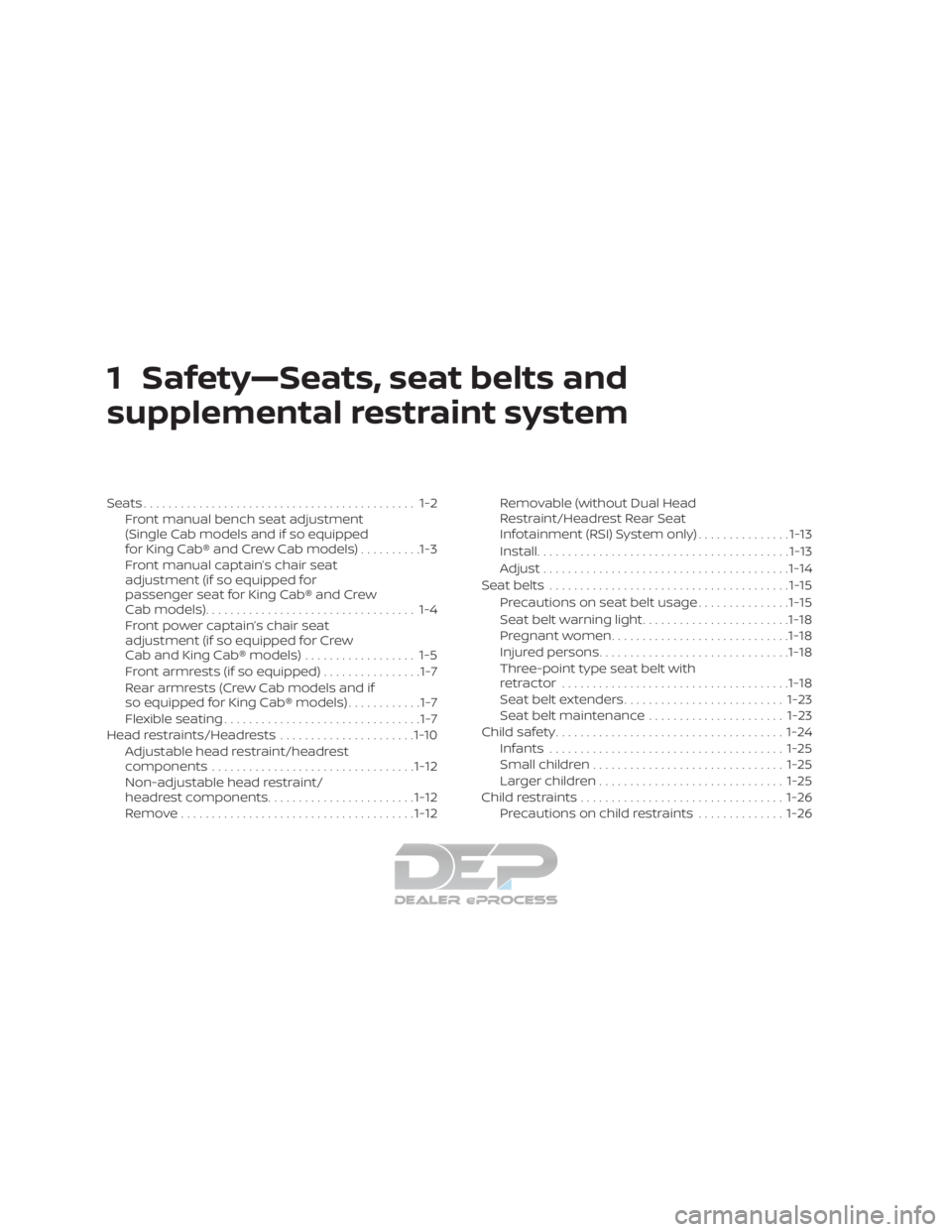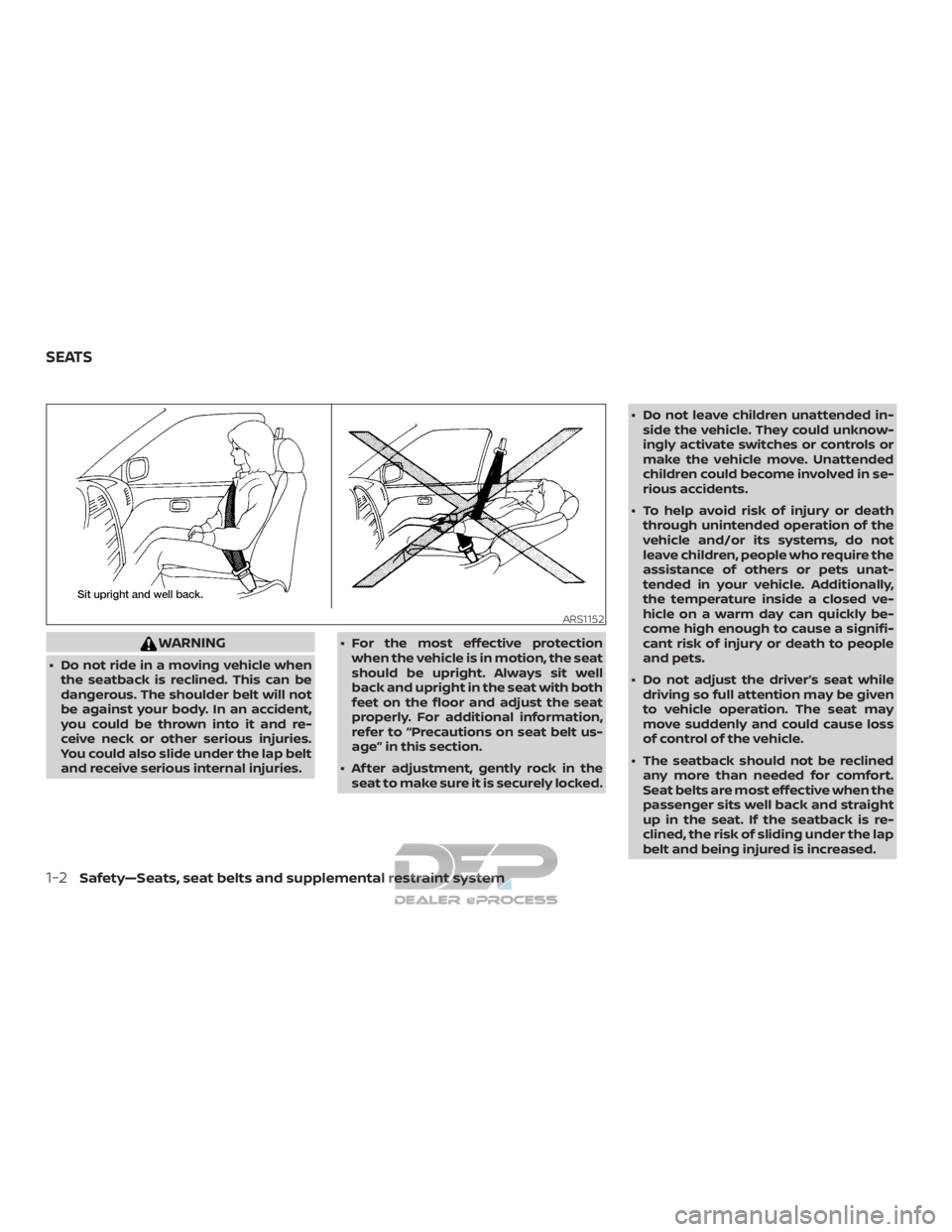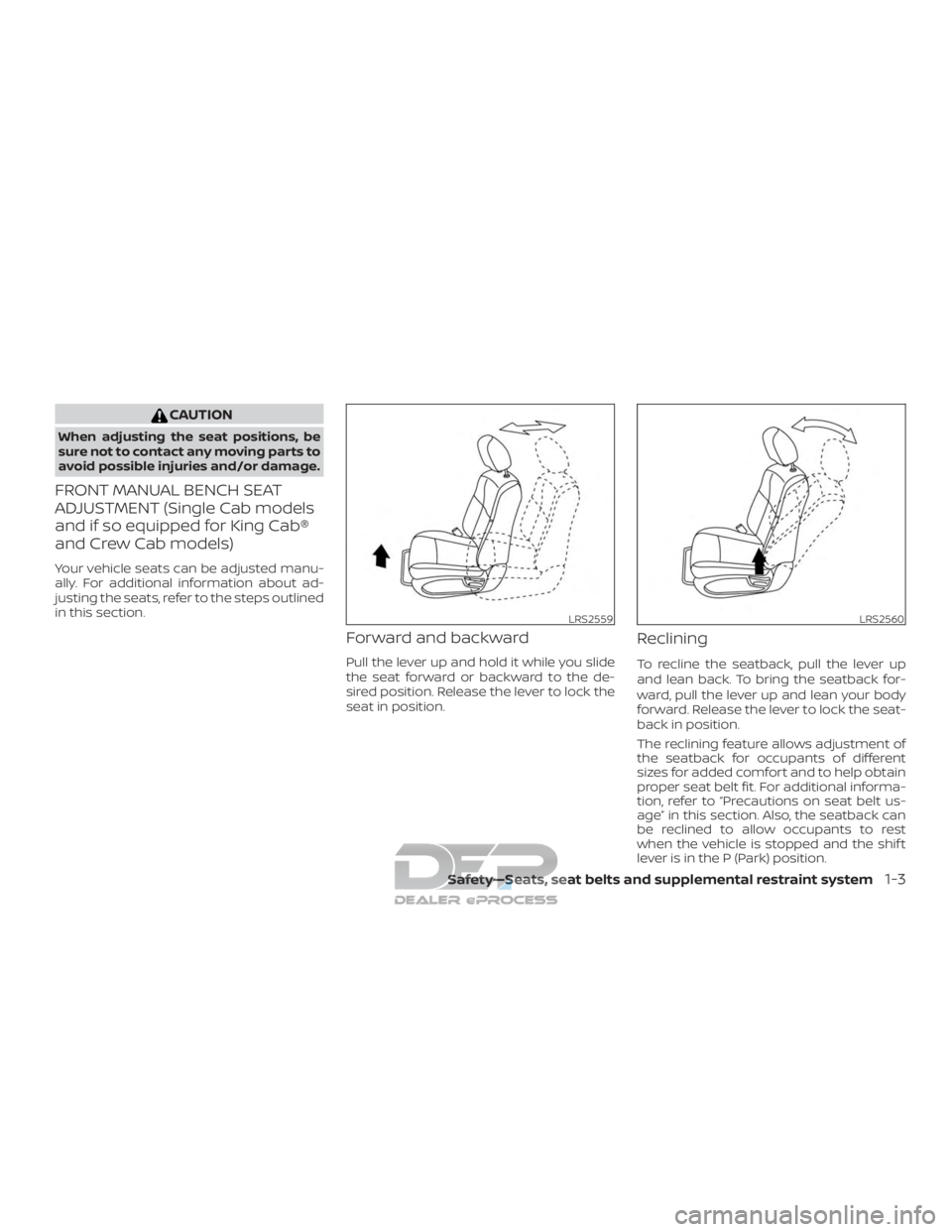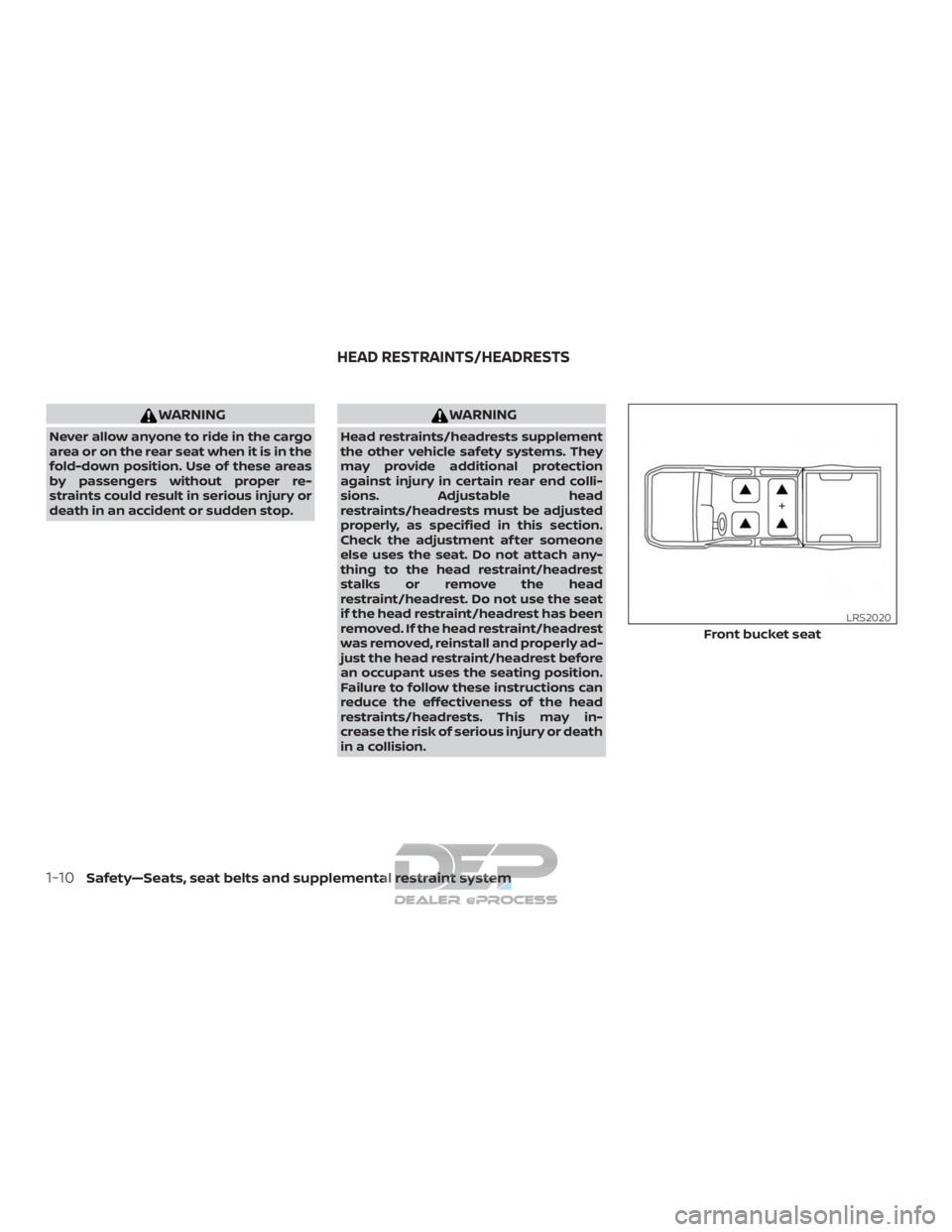Page 24 of 682
Table of
ContentsIllustrated table of contents
Safety—Seats, seat belts and supplemental restraint system
Instruments and controls
Pre-driving checks and adjustments
Monitor, climate, audio, phone and voice recognition systems
Starting and driving
In case of emergency
Appearance and care
Do-it-yourself
Maintenance and schedules
Technical and consumer information
Index
0
1
2
3
4
5
6
7
8
9
10
11
Page 41 of 682

1 Safety—Seats, seat belts and
supplemental restraint system
Seats............................................ 1-2Front manual bench seat adjustment
(Single Cab models and if so equipped
for King Cab® and Crew Cab models) ..........1-3
Front manual captain’s chair seat
adjustment (if so equipped for
passenger seat for King Cab® and Crew
Cab models) .................................. 1-4
Front power captain’s chair seat
adjustment (if so equipped for Crew
Cab and King Cab® models) .................. 1-5
Front armrests (if so equipped) ................1-7
Rear armrests (Crew Cab models and if
so equipped for King Cab® models) ............1-7
Flexible seating ................................1-7
Head restraints/Headrests ......................1-10
Adjustable head restraint/headrest
components ................................. 1-12
Non-adjustable head restraint/
headrest components ........................ 1-12
Remove...................................... 1-12Removable (without Dual Head
Restraint/Headrest Rear Seat
Infotainment (RSI) System only)
...............1-13
Install ......................................... 1-13
Adjust ........................................ 1-14
Seatbelts ....................................... 1-15
Precautions on seat belt usage ...............1-15
Seat belt warning light ........................ 1-18
Pregnant women ............................. 1-18
Injured persons ............................... 1-18
Three-point type seat belt with
retractor ..................................... 1-18
Seat belt extenders .......................... 1-23
Seat belt maintenance ......................1-23
Child safety ..................................... 1-24
Infants ...................................... 1-25
Small children ............................... 1-25
Larger children .............................. 1-25
Child restraints ................................. 1-26
Precautions on child restraints ..............1-26
Page 43 of 682

WARNING
∙ Do not ride in a moving vehicle whenthe seatback is reclined. This can be
dangerous. The shoulder belt will not
be against your body. In an accident,
you could be thrown into it and re-
ceive neck or other serious injuries.
You could also slide under the lap belt
and receive serious internal injuries. ∙ For the most effective protection
when the vehicle is in motion, the seat
should be upright. Always sit well
back and upright in the seat with both
feet on the floor and adjust the seat
properly. For additional information,
refer to “Precautions on seat belt us-
age” in this section.
∙ Af ter adjustment, gently rock in the seat to make sure it is securely locked. ∙ Do not leave children unattended in-
side the vehicle. They could unknow-
ingly activate switches or controls or
make the vehicle move. Unattended
children could become involved in se-
rious accidents.
∙ To help avoid risk of injury or death through unintended operation of the
vehicle and/or its systems, do not
leave children, people who require the
assistance of others or pets unat-
tended in your vehicle. Additionally,
the temperature inside a closed ve-
hicle on a warm day can quickly be-
come high enough to cause a signifi-
cant risk of injury or death to people
and pets.
∙ Do not adjust the driver’s seat while driving so full attention may be given
to vehicle operation. The seat may
move suddenly and could cause loss
of control of the vehicle.
∙ The seatback should not be reclined any more than needed for comfort.
Seat belts are most effective when the
passenger sits well back and straight
up in the seat. If the seatback is re-
clined, the risk of sliding under the lap
belt and being injured is increased.
ARS1152
SEATS
1-2Safety—Seats, seat belts and supplemental restraint system
Page 44 of 682

CAUTION
When adjusting the seat positions, be
sure not to contact any moving parts to
avoid possible injuries and/or damage.
FRONT MANUAL BENCH SEAT
ADJUSTMENT (Single Cab models
and if so equipped for King Cab®
and Crew Cab models)
Your vehicle seats can be adjusted manu-
ally. For additional information about ad-
justing the seats, refer to the steps outlined
in this section.
Forward and backward
Pull the lever up and hold it while you slide
the seat forward or backward to the de-
sired position. Release the lever to lock the
seat in position.
Reclining
To recline the seatback, pull the lever up
and lean back. To bring the seatback for-
ward, pull the lever up and lean your body
forward. Release the lever to lock the seat-
back in position.
The reclining feature allows adjustment of
the seatback for occupants of different
sizes for added comfort and to help obtain
proper seat belt fit. For additional informa-
tion, refer to “Precautions on seat belt us-
age” in this section. Also, the seatback can
be reclined to allow occupants to rest
when the vehicle is stopped and the shif t
lever is in the P (Park) position.
LRS2559LRS2560
Safety—Seats, seat belts and supplemental restraint system1-3
Page 45 of 682
Front center bench seat
adjustment
The front center bench seat folds down by
pulling on the strap. It does not have ad-
justments in between the upright and the
folded down positions. It is either in seating
position or armrest position.
FRONT MANUAL CAPTAIN’S CHAIR
SEAT ADJUSTMENT (if so equipped
for passenger seat for King Cab®
and Crew Cab models)
Your vehicle seats can be adjusted manu-
ally. For additional information about ad-
justing the seats, refer to the steps outlined
in this section.
Forward and backward
Pull the lever up and hold it while you slide
the seat forward or backward to the de-
sired position. Release the lever to lock the
seat in position.
LRS2787LRS2559
1-4Safety—Seats, seat belts and supplemental restraint system
Page 46 of 682

Reclining
To recline the seatback, pull the lever up
and lean back. To bring the seatback for-
ward, pull the lever up and lean your body
forward. Release the lever to lock the seat-
back in position.
The reclining feature allows adjustment of
the seatback for occupants of different
sizes for added comfort and to help obtain
proper seat belt fit. For additional informa-
tion, refer to “Precautions on seat belt us-
age” in this section. Also, the seatback can
be reclined to allow occupants to rest
when the vehicle is stopped and the shif t
lever is in the P (Park) position.
FRONT POWER CAPTAIN’S CHAIR
SEAT ADJUSTMENT (if so equipped
for Crew Cab and King Cab®
models)
Operating tips
∙ The power seat motor has an auto-reset overload protection circuit. If the
motor stops during operation, wait
30 seconds then reactivate the switch.
∙ Do not operate the power seat switch for a long period of time when the en-
gine is off. This will discharge the bat-
tery. For additional information, refer to “Auto-
matic drive positioner” in the “Pre-driving
checks and adjustments” section of this
manual.
Forward and backward
Moving the switch as shown will slide the
seat forward or backward to the desired
position.
LRS2560LRS2743
Safety—Seats, seat belts and supplemental restraint system1-5
Page 47 of 682
Reclining
Move the recline switch as shown until the
desired angle is obtained.
The reclining feature allows adjustment of
the seatback for occupants of different
sizes for added comfort and to help obtain
proper seat belt fit. For additional informa-
tion, refer to “Precautions on seat belt us-
age” in this section. Also, the seatback can
be reclined to allow occupants to rest
when the vehicle is stopped and the shif t
lever is in P (Park).
Seat lif ter (driver’s seat)
Move the switch as shown to adjust the
angle and height of the seat cushion.
Lumbar support (driver’s seat)
The lumbar support feature provides ad-
justable lower back support to the driver.
Push the switch as shown to adjust the
seatback lumbar area.
LRS2744LRS2745
1-6Safety—Seats, seat belts and supplemental restraint system
Page 51 of 682

WARNING
Never allow anyone to ride in the cargo
area or on the rear seat when it is in the
fold-down position. Use of these areas
by passengers without proper re-
straints could result in serious injury or
death in an accident or sudden stop.
WARNING
Head restraints/headrests supplement
the other vehicle safety systems. They
may provide additional protection
against injury in certain rear end colli-
sions. Adjustable head
restraints/headrests must be adjusted
properly, as specified in this section.
Check the adjustment af ter someone
else uses the seat. Do not attach any-
thing to the head restraint/headrest
stalks or remove the head
restraint/headrest. Do not use the seat
if the head restraint/headrest has been
removed. If the head restraint/headrest
was removed, reinstall and properly ad-
just the head restraint/headrest before
an occupant uses the seating position.
Failure to follow these instructions can
reduce the effectiveness of the head
restraints/headrests. This may in-
crease the risk of serious injury or death
in a collision.
Front bucket seat
LRS2020
HEAD RESTRAINTS/HEADRESTS
1-10Safety—Seats, seat belts and supplemental restraint system